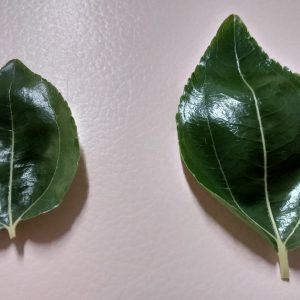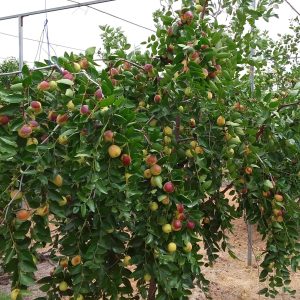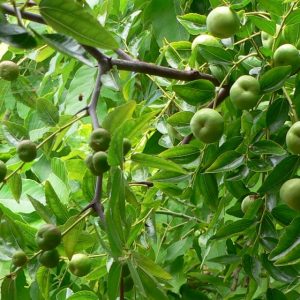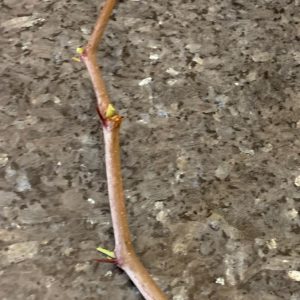Ziziphus jujuba
Jujube, Chinese date
Origin
Jujube is native to China, particularly the more arid areas. It has been cultivated there for at least 7000 years, and production exceeds 4 MT pa. Other countries contribute to global production but in smaller quantities.
Climate
It has a very low chilling requirement for flowering and favours a sub-tropical environment. Ideal mean temperatures range from 5-22°C. Mature trees are extremely drought tolerant (as low as 200mm pa) but will also withstand rainfall up to 2000mm pa providing soil is well-drained. Mature trees in dormancy are known to have survived winter cold of -38°C.
Plant Description
It is a small glabrous tree possibly growing to a height of 10m with grey-brown bark and a very deep root system. Branching in jujube trees is complicated, with 4 types each having different functions: primary (extension), secondary (side branches), mother-bearing (MB, fruiting spur), and fruit-bearing (branchlet). There are also (principally) 2 types of buds, main and secondary, and these occur at each node in primary, secondary and MB branches. The main bud of the primary branch will keep expanding the tree canopy with primary and MB branches, while the secondary buds can produce secondary branches. In secondary branches the main bud can produce primary or MB branches, and secondary buds can form fruiting branchlets. In MB branches, the main bud can produce primary or MB branches, and secondary buds the fruiting branchlets. The MB branch grows very slowly, only 1-2 mm pa, and can produce several branchlets each season. All but MB branches are zig-zagged, and fruiting branchlets are deciduous and form annually. The most common named varieties within Z jujuba var jujuba have spines at branch nodes that may be straight but often with one recurved; there are some less cultivated varieties that are spineless (eg Z jujuba var inermis). Green ovate-elliptic alternate petioloate deciduous leaves 3-7 X 1.5-4cm with crenate–serrate margins are dark green upper and pale green lower with three longitudinal veins.
Relatives
Rhamnaceae Family. There are about 100 species of Ziziphus, most originating in the old world. The only other species valued equivalently for its fruit is Indian jujube or Ber, Z. mauritiania. Indian jujube is more thorny and prone to massive suckering than jujube, and is a declared weed in many parts of Australia, including WA. Jujube is the first species in the family to have its genome sequenced.
Soils
Grows in a very wide range of soils from pH 5.5 to 8.5 and salinity up to 6dS/m. Mycorrhizal associations are formed and these assist with water and nutrient requirements.
Propagation
Seeds should preferably be used only to provide rootstock material for grafting superior cultivars as otherwise productivity is highly variable. The plant can sucker profusely and these are the easiest and main source of rootstocks. Standard grafting techniques present no major problems but cuttings have not been very successful. Most of the traditional cultivars have been the result of opportunistic selection, but more recently several cvs have been released as a result of controlled breeding.
Cultivars
There are more than 900 named varieties in China. The most common ones grown in Australia and able to be sourced are Chico (apple-shaped), Li (round) and Lang (pyriform). Chico is probably the best all-round performer in WA.
Flowering and Pollination
Inflorescences are 2-8 (rarely solitary) flowered cymes borne in the leaf axils of the small deciduous branchlets in spring. The small hermaphrodite pentameric flowers, 5-7mm dia, have triangular yellow-green sepals and pale yellow non-showy petals clawed at the base and the same length as the stamens. The perigynous ovary has 2 ovules surrounded by a thick fleshy 5-10 lobed nectary disk, and a connate style where the stigma divides in two when receptive. Each flower lasts only 1- 2 days but blooming over a whole branchlet may last 4-6 weeks. Flowers are protandrous and there are two types, A and B. A types are in the male phase with pollen release in the morning and the female stigma receptive in the afternoon, whereas in B types the male phase is in the afternoon and female the following morning. Low temperatures and rainy weather can disrupt these processes. Some varieties can set fruit parthenocarpically provided they’ve been pollinated. Selfpollination results in fruit set, but usually almost all fruitlets abscise before maturity and do not contain viable seeds, ie there is genetic self-incompatibility. Pollen viability in most cvs is less than 50%, and fruit set is typically less than 2%. The fragrant flowers are attractive to many species of insects that effect pollination; wind is not effective with the sticky pollen. Some varieties are polyploid, complicating cross-pollination.
Cultivation
The plants require full sun and regular fertilizer applications for heavy fruiting. They can survive dry periods but productivity is improved with adequate water supply.
Wind Tolerance
This is best during dormancy. Normal flowering and fruit set is affected by strong winds.
Pruning
Suckers should be removed otherwise a thicket of trees can eventuate. They are best trained as a vase-shaped bush with several main lateral (secondary) branches. Maintaining height to a maximum of 3-5m is relatively straightforward.
The Fruit
It is a 2-3 X 1.5-2cm dry-fleshed drupe formed from the ovary and nectary disk, green-yellow turning red-brown when ripe, and varying in size and shape (round, oblong, ovate, obovate oblate) depending on cultivar and management. The single woody stone, acute at both ends, is formed from the endocarp and may contain 0-2 seeds. Fruit are thin skinned and easily bruised. The edible low-acid flesh contains more than 20% carbohydrates (mainly sucrose) and is a good source of calcium, iron and vitamin C if not dried.
Fruit Production and Harvesting
The juvenile period is 2-3 years, less if grafted, with full production ramping up over several years. Fruiting is staggered and usually extends throughout summer/early autumn. Fruit splitting can be a problem, and fruit can be stored at 4°C for more than 2 months if still at the green mature stage, less when red-brown ripe. Trees have been known to produce fruit for centuries.
Fruit Uses
It is usually eaten fresh, dried, candied, smoked or pickled.
Pests and Diseases
It is a very hardy plant, usually trouble free if in good health. Fruit flies, and the phytoplasma Witches Broom can cause problems. Disease risk increases in very humid environments.
Comments
This species is almost designed for our climate, being able to withstand our hot dry summers. If a good cultivar is selected and managed well it can produce prolifically, with reports of many thousands of fruits carried on mature trees. You’ll likely get more fruit if you have a second variety for cross-pollination, or have a graft on the one plant. Downsides are the spines and suckering.



